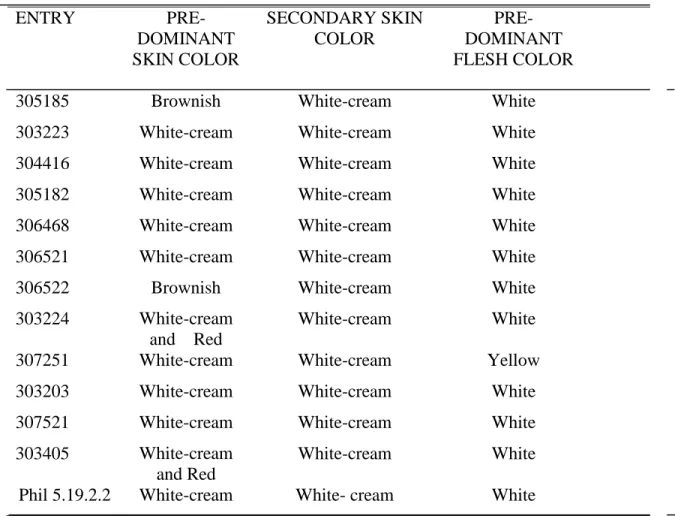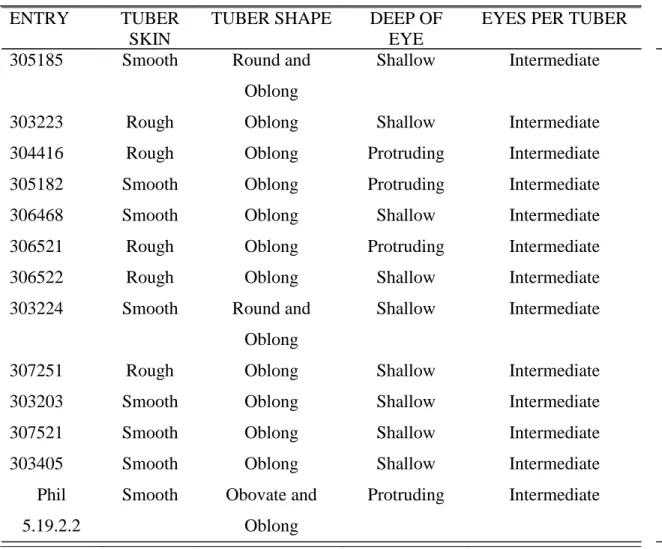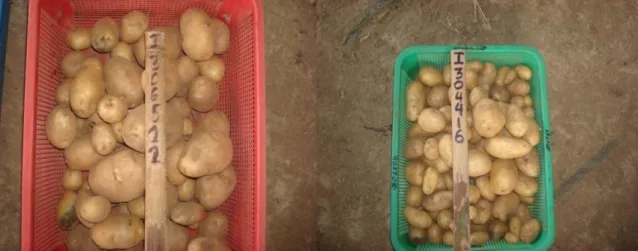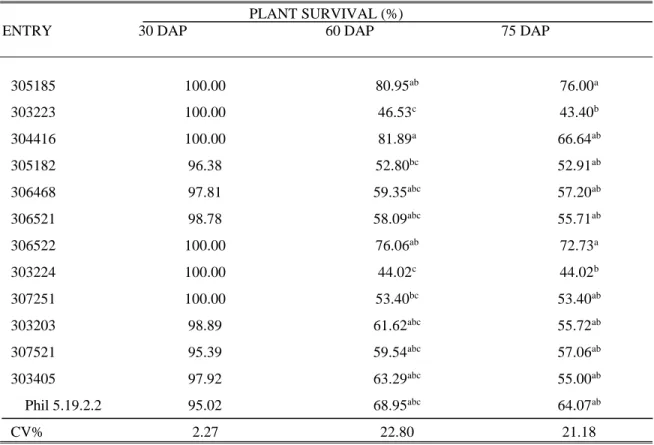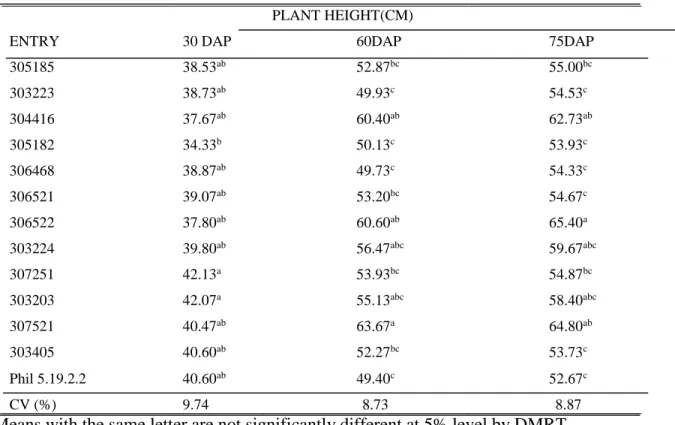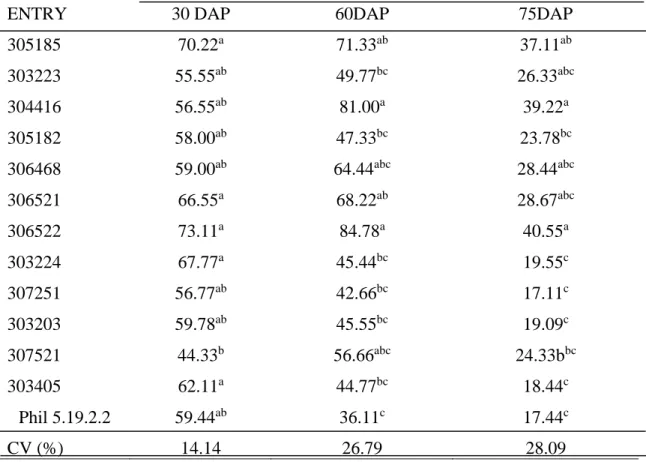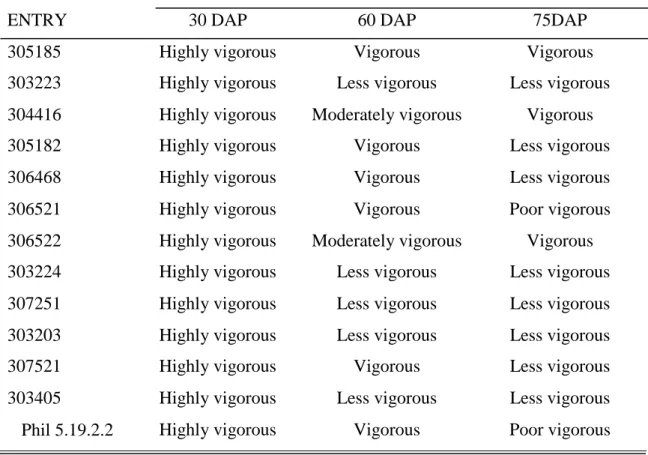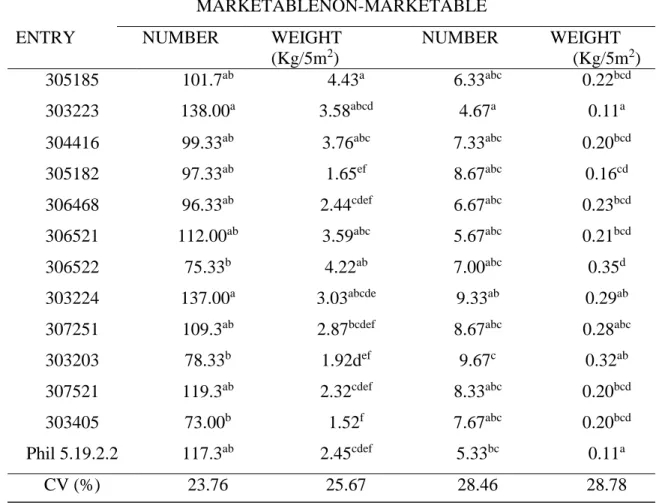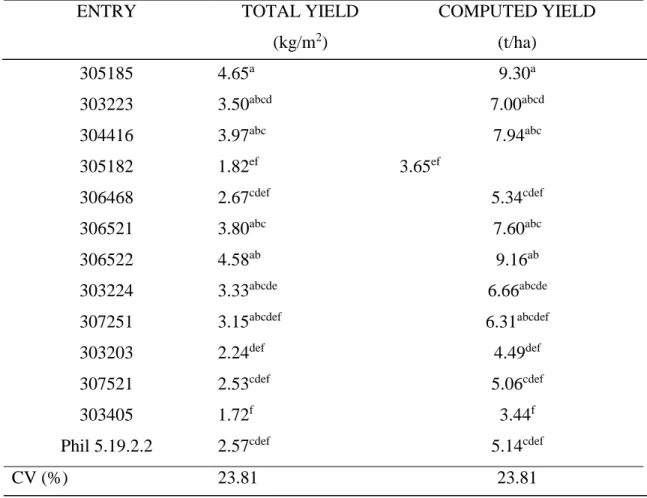BIBLIOGRAPHY
ALUMIT, GENESIS B, April 2013. Characterization and Evaluation of PotatoEntries for Organic Production System in La Trinidad, Benguet.Benguet State University, La Trinidad, Benguet.
Adviser: Belinda A. Tad-awan, PhD.
ABSTRACT
The study was conducted to morphologically characterize the different potato entries; determine the best performing entries under organic production; and to determine the profitability of using the different potato entries under organic production.
Variation among the tuber skin color was observed. Tuber ranged from white cream, red and brown. High dry matter content was obtained in all the entries except for entry 306522. Entries 303223, 303405, 304416 and 307521 were acceptable based on their sensory characteristics.
Potato entries 305185, 304416 and 306522 out yielded the other potato entries and were observed resistant to late blight infection. These entries also obtained high return on cash expense, therefore, recommended for organic production in La Trinidad, Benguet.
INTRODUCTION
The potato (Solanum tuberosum L.) is a high yielding short duration crop that produces high dry matter and protein per unit area and unit time. In terms of quantity, potatoes are the fourth on the list of the crop species after rice, wheat, and corn which are important to human nutrition worldwide. Thus, potatoes have a great potential to meet the increasing food demand worldwide. According to Perez et al. (2006) potato is major cash crop in highlands and mid elevation areas in Mindanao, because it has a short growing period, a potential for high yield in a growing market for fresh and process potato. In addition the total potato production comes from Benguet and Mountain Province is about 74 %, while the remaining 26% were from Southern and Northern parts of Mindanao (PCARRD, 1997).
It is known that farmers in Benguet and Mountain Province use tremendous amount of synthetic fertilizers and pesticides to increase their production, however, these practices as claimed by researchers may lead to soil acidity, decrease population of natural enemies, pollution of the soil, water, and air which may cause health hazards. In this case, alternative production practices should be practiced. One of these practices is organic farming or organic agriculture.
According to Petzoldt (2005) organic farming is a method of production that uses practices or materials which are biologically enhancing to the soil and plants. The principle of organic farming is to replenish and maintain long term soil fertility by providing the optimal condition for biological activity. Encouraging the use of local resources, recycled nutrient and maintaining Biodiversity that will minimize the occurrence of pests.
Potato is considered as one of the most important crops in Benguet, however, lack of superior cultivars, the destruction caused by insect pest and the unavailability of good quality seed tuber is a constraint as claimed by farmers.
Organic potato production needs a variety that is suitable to the environment, resistant against pests, and diseases and high yielding. Resistant varieties can help the farmers not to use synthetic insecticides and fungicides therefore, it is important to evaluate varieties for organic production. Evaluation of potato for organic production should be conducted to determine their adaptability and stability in terms of yield, resistance to pest and disease and level of uniformity in the farmers field (Anon, 2005).
The study was conducted to:
1. morphologically characterize the different potato entries;
2. determine the best performing potato entries in terms of yield and resistance to pests under organic production at La Trinidad, Benguet condition; and
3. determine the profitability of using the different potato entries under organic production.
The study was conducted at Balili, Experimental Station, Benguet State University, La Trinidad, Benguet from November 2012 to February 2013.
REVIEW OF LITERATURE
Significance of Varietal Evaluation
Thomson and Kelly in 1957 stated that testing of variety is essential, but after testing, attention should be given because there is great difference in yield, size, ear lines and others. It is only by several trials that the superior strains are found.
Cagampang and Lantican (1977) observed that the wise use of an improved and well selected variety may result in tremendous increase in yield. But growing the wrong cultivar may mean crop failure because of disease infection and diverse climatic condition.
Selection of suitable cultivars is an important is an important step in the farm planning process but the availability of large number of variety makes the selection of a variety for a given field is difficult. Also there are many aspects which have to be considered before it is possible to make an opinion of which one of the available cultivar well be the most suited for growing (Boesen et al., 1997).
Varietal Evaluation of Potato under Organic Production
In the study of Gibson (2002) in La Trinidad, Granola, Igorota and CM 9 produced the highest marketable yield with low bacterial wilt infection, while genotypes IP 84004.7 and 13.1.1 also produced comparable yield with the other genotypes but were highly infected with bacterial wilt. The study recommended Granola, Igorota and CM9, for planting under La Trinidad, Benguet during the dry season planting.
According to Gayomba (2006), genotype 13.1.1 had the highest canopy cover, highest resistance to late blight and highest total yield. Genotype 13.1.1 also had the highest ROCE
676070, and 5.19.2.2 could be produced in the area since the genotypes were selected by the farmers.
Montes and Tad-awan (2006) in their evaluation of potato varieties for organic production found that CIP genotype IP 84007.67, 676070 and CIP 13.1.1 were resistant to late blight at 60 and 75 DAP in Longlong La Trinidad. For seed tuber production, genotype 380251.17 produced the highest return on cash expense. Further, the farmer-cooperator selected IP84007.67, 676089 and Ganza due to their high yield and resistance to late blight.
Potato accessions CIP 13.1.1, CIP 676089, CIP 380251.17, BSU 5.1.19.2.2 and CIP 676070 produced the highest tuber yield per hill across locations and planting seasons.
These accessions also showed resistant to late blight in all production sites (Tad-awan et al., 2007).
It has been found by Daproza (2009) in his study at Balili, La Trinidad that TPS 15 potato progeny had the highest percent survival, while TPS 14 and TPS 11 potato progenies have low percentage survival. Potato progenies TPS 15, TPS 12, TPS 16 were observed to be vigorous and resistant to late blight. The highest yielding progeny was TPS 15 with 4,380 kg/ 15m2. TPS 15 produced the highest number of tuber per hill.
In a related study by Sawak (2010) in Buguias, Benguet, Ganza obtained the highest percent survival, exhibited the tallest plant, highest canopy cover and highly vigorous plants at 75 DAP. MLUSA 5, MLUSA 8 and Ganza were rated moderately resistant to frost injury at 60 and 75 DAP. All of the entries were moderately resistant to leaf miner.
Ganza produced the heaviest marketable and non-marketable tubers and had highest return on cash expenses (ROCE).
Mendoza (2011) evaluated seven progenies under organic production in La Trinidad, Benguet. The result of the study showed that progeny 303617 had the highest total number of potato tubers, while progeny 306521 produced the heaviest weight, but comparable to progeny 306468 and 303610.
MATERIALS AND METHODS
Land Preparation
An area of 195 m2 was thoroughly prepared and further divided into three blocks. Each block was subdivided into thirteen plots measuring 1m x 5m representing the thirteen treatments.
Cultural Management Practices
Organic production practices were employed during the conduct of the study. BSU Grower’s Compost was incorporated into the soil at the rate of 5kg/m2 one week before sowing, while Vermi-compost was incorporated at hilling-up with a rate of 5kg/m2. Weeding and irrigation were employed in order to maintain the vigorous growth of the plants. Planting of marigold and other crops within the area were done for diversification purpose and to reduce pest occurrence.
Planting Materials and Treatments
Potato seed tubers were used as planting material. The potato entries were selected from the project “Variety evaluation, on farm trials and seed production of organic vegetable in CAR”.
The treatments were as follows:
CodePotato Entries
E1 305185
E2 303223
E3 304416
E4 305182
E5 306468
E6 306521
E7 306522
E8 303224
E9 307251
E10 303203
E11 307521
E12 303405 E13 Phil 5.19.2.2
Experimental lay-out and Planting
The experiment was laid-out following the randomized complete block design (RCBD)with three replications. Seed tubers were planted at a distance of 30cm x 30 cm.
Data gathered:
A. Morphological characters (CIP, 2001) 1. LeafCharacters
a. Leaf Dissection. This describes the degree of leaf dissection expressed as:
1 Undissected – entire leaves.
2 Pinatilobed – leaves with lobes extending almost to the midribs.
3 Scarcely dissected – leaves with terminal and primary lateral leaflets only.
4 Weakly dissected – leaves with terminal and primary lateral leaflets and some secondary interjected leaflets on the rachis.
5 Medium dissected – leaves with terminal and primary lateral leaflets and interjected leaflets from the second to the fifth order
on the rachis.
6 Strongly dissected – leaves with terminal and primary lateral leaflet, interjected of the second, third etc. Order on the rachis
and one to three interjected leaflets on the petiolules.
7 Very strong dissected – leaves with terminal and primary lateral leaflet, intersected leaflets of the second, third, etc. Order on the rachis and more than three interjected leaflets on the petiolules
and rachidules.
b. Adaxial leaf pubescence. This represents the degree to which the lower surfaces of the leaves are covered by hairs (trichomes) expressed as:
0 Glabrous – when hairs are absent
1 Glabrescent – when the pubescence is very sparse 2 Pubescence
3 Strongly pubescent
c. Type of hairs (trichomes). This describes the type of hair in the lower surface of the leaves expressed as:
0 Absent
1 Simple – simple trichomes.
2 Simple and Glandular – simple trichomes and glandular trichomes bearing a sticky four 0 – lobed head.
3 Simple and Glandular – simple trichomes and glandular trichomes with a sticky droplet at the tip.
4 Simple and Glandular – simple trichomes and both type of
glandular trichomes present.
2. Stem Character
a. Stem color. This indicates the color of the stems expressed as:
1 Green only 2 Red-brown only 3 Purple only
4 Cream with some red-brown 5 Cream with purple
6 Red-brown with some green 7 Purple with some green 8 Others
3. Tuber Characters
a. Predominant tuber skin color. These are the color which covers most of the surface of the tuber expressed as:
1 White-cream 2 Yellow 3 Orange 4 Brownish 5 Pink 6 Red 7 Purple
9 Dark purple-black
b. Secondary tuber skin color. These describe the color on the surface of the tuber expressed as:
0 Absent 1 White-cream 2 Yellow 3 Orange 4 Brownish 5 Pink 6 Red
7 Purplish-black 8 Purple
9 Dark purple-black c. Tuber skin type. This is expressed as:
1 Smooth 2 Rough
3 Partially netted 4 Totally netted 5 Very heavily netted 6 Others
d. Pre-dominant tuber flesh color. This indicates the flesh color present in most of the tuber expressed as:
1 White 2 Cream
3 Yellow-cream 4 Yellow
5 Red 6 Violet 7 Purple 8 Others
e. Secondary tuber flesh color. This represents the secondary flesh color in the tuber expressed as:
0 Absent 1 White 2 Cream
3 Yellow-cream 4 Yellow 5 Red 6 Violet 7 Purple
f. General tuber shape. This indicates the tuber outline expressed as:
1 Compressed (oblate) – major axis is the shortest axis.
2 Round – an almost circular outline
3 Ovate – an outline resembling an egg. The broadest part is within 1/3 of the distance from the stolon end.
4 Obovate – an outline which is inversely ovate and broadest within 1/3 of the distance from the apical end.
5 Elliptic – an outline showing the same breadth when measured at equal distance from both the stolon and apical end. The outline is slightly acute at each end.
6 Oblong – an almost rectangular outline with the sides nearly parallel but the corners rounded. The length/breadth ratio should not be more than 3/2.
7 Long-oblong – an oblong outline with a length/breadth ratio closer to 2/1.
8 Elongate – a long rectangular outline with a length/breadth ratio equal to or more than 3/2.
g. Unusual tuber shape. This represent those variants of tuber shape which cannot be described under general tuber shape and expressed as follows:
0 Absent
1 Flattened – when the length of a transverse section, at any point of the tuber, is more than three times longer than its breadth.
2 Clavate – resembling an elongated club, thickened at one end.
3 Reniform – shaped like a kidney.
4 Fusiform – spindle-shaped, tapering gradually at both ends.
5 Falcate – curved or shaped like a sickle or horseshoe.
6 Spiral – long and coild.
7 Digitate – resembling a hand or a fist.
8 Concertina-shaped – resembling a concertina.
9 Tuberosed – covered with few or many small lamps and tubers. It includes those shaped, like a pineapple, a cluster of grapes, and raised internodes.
h. Depth of tuber eyes. This indicates the depth of the eye in the tuber expressed as:
1 Protruding 2 Shallow 3 Medium 4 Deep 5 Very deep
i. Eyes per tuber. This represents the number of eyes expressed as:
1 Few (less than 5) 5 Intermediate
10 Many (more than 20) B.Growth Characters
1. Plant survival (%). The number of plants that survived were counted at 30, 60 and 75 days after planting(DAP) and calculated using the formula:
Number of plants survived % Survival = x 100
Total number of plants planted
2. Plant height. Plant height was measured at 30, 60, and 75 DAP using a meter stick.
3. Canopy cover. Canopy cover was recorded at 30, 60, and 75 DAP using a wooden frame which measures 120 cm x 60 cm and having an equal size of grid of 12 cm x 6 cm grids. Holding the grids over the foliage of four marked plants, grids covered with effective leaves will be counted.
4. Plant vigor. Plants were rated at 30, 60, and 75 DAP based on a rating scale by (CIP, 2001):
Scale Description Reaction 5 Plant is strong with robust stems and Highly Vigorous leaves, light color to dark green in color.
4 Plants are moderately strong with robust Moderately Vigorous stem and leaves were light green.
3 Better than less vigorous. Vigorous
2 Plants are weak with few thin stems and Less Vigorous leaves pale.
1 Plants are weak with few stems and leaves, Poor Vigorous very pale.
C. Yield and Yield Components
1. Number and weight of marketable tubers per plot (kg). All the tubers that were of marketable size, not malformed, free from cuts cracks and without more than 10%
greening of the total surface was counted and weighed at harvest.
2. Number and weight of non-marketable tubers per plot (kg). This was obtained by counting and weighing all tubers that are malformed, damage by pest and disease and those with more than 10% greening.
3. Total yield per 5m2(kg). This is the sum of the weight of marketable and non- marketable tubers per plot.
4. Computed Yield (t/ha). This was computed using the formula:
Total Yield
Computed Yield (t/ha) = x 10,000 Plot Size (m2/1,000)
D. Cost and Return Analysis. The cost of production, gross sale, net profit, and return on cash expense were determined, Return on cash expense was computed by using the formula:
Net Income
Return on Cash Expense = x 100 Total Cost of Production
E. Reaction to Pest and Diseases
1. Reaction to leaf miner. The reaction to leaf miner was recorded at 30, 60, 75 DAP using the following rating scale (CIP, 2001):
ScaleDescriptionReaction
1 Leaf infected (1-20%) Highly Resistant 2 Infected (20-40%) Moderately Resistant 3 Moderately infected (41-60%) Susceptible
4 Severely infected (61-80%) Moderately Susceptible 5 Most serious (81-100%) Very Susceptible
2. Reaction to late blight. Rating was done at 30, 60, and75 DAP using a rating scale (CIP, 2001) as follows:
%Blight Scale Description
0 1 No blight observed
Traces-<5 2 Blight is present at maximum of 10 lesions per plot.
5-<15 3 Plant look healthy but lesions are easily seen at closer distance. Maximum foliage is one
affected by lesions or destroyed corresponds to more than 2 leaflets.
15->35 4 Blight easily sees on most plants. About 25%
foliage is covered with lesions or destroyed.
35->65 5 Plots looks green; however all plants are affected. Low leaves are dead and about 1/2 of the foliage are destroyed.
65-<85 6 Plots look green with brown flocks about 75%
each plant is affected. A left or lower half of the plant is destroyed.
85->95% 7 Plant is either predominant green or brown only top leaves are green.
95-<100 8 Plots colored brown. A few top leaves have green areas. Most stems leave lesions are dead.
100 9 All leaves and stems are dead.
Description: 1-highly resistant, 2-3- resistant, 4-5- moderate resistant, 6-7- moderate susceptible, 8-9- susceptible
F. Postharvest Characters
1. Dry matter content of tubers. Twenty gram of tubers was weighed and sliced into cubes and oven dried at 800C for 24 hrs. This was recorded and computed using the following formula:
Dry mattercontent (%) = 100% - % moisture content
Fresh weight – Oven dry weight Where: % Moisture Content = x 100%
Fresh weight
2. Sugar Content (0Brix). This was taken by extracting the juice of 20 g potato tubers and read on a digital refractometer.
3. Sensory Evaluation. Storage roots harvested were washed and boiled and evaluated by fifteen evaluators compressed of faculty members and students. Evaluation was based in
terms of appearance, color, texture, flavor and general acceptability following the 1-5 scale.
This was the basis to determine the eating quality.
Rating Description 1 Dislike very much
2 Dislike moderately 3 Neither like nor dislike 4 Like moderately 5 Like very much G. Agro-climatic Data.
Temperature, relative humidity, rainfall were recordedduring the conduct of study.
Data Analysis
All quantitative data were analyzed using the Analysis of Variance (ANOVA) for Randomized Complete Block Design (RCBD) with three replications. The significance of difference among the treatment means was tested using the Duncan’s Multiple Range Test (DMRT) at 5% level of significance.
RESULTS AND DISCUSSION
Meteorological Data
Table 1 shows the monthly mean temperature, relative humidity, rainfall and sunshine duration during the conduct of study. The monthly mean temperature ranged from 13.1 0C to 23 0C. During the month of January, air temperature was the highest. The lowest relative humidity was noted in the month of November with 84.75%, while the highest was noted in the month of December with 86.5%. Very little rainfall was noted (0.15 to 2.19 mm).
The temperature and relative humidity during the conduct of study was favorable.
Temperature is important in potato plants because it enhance the accumulation of carbohydrates and dry matter in the tubers. The optimum temperature for potato production was reported to be ranging from 17-22 0C and a relative humidity of 86% (HARRDEC, 1996). The lowest sunshine duration was noted in the month of November at 11.09 min while the highest was observed in the month of January with 360 min.
Table 1. Meteorological data from October 2012 to January 2013
MONTH
TEMPERATURE (0C)
RELATIVE HUMIDITY
RAINFALL (mm)
SUNSHINE DURATION
MIN MAX (%) (min)
October 15.1 23.00 85 2.19 11.09
November 13.1 20.9 84.75 1.33 10.97
December 13.2 22.6 86.5 0.15 12.18
January 18.3 23.7 80 0.5 360
Morphological Characters
Leaf Dissection, Adaxial Leaf Pubescence Type of Hair and Stem color of the potato entries
Generally, all the entries had similar characteristic. For the leaf dissection, all the entries were scarcely dissected having terminal and primary lateral leaflet only (Figure 1). In terms of adaxial leaf pubescence, all the entries had strongly pubescence where the upper surface of the leaves is covered with fine short hairs or trichomes only and simple and glandular for the type of hair. For the stem color, all the entries are colored green.
Pre-dominant and Secondary tuber skin color Pre-dominant and Secondary tuber flesh color
Table 2 shows the tuber characters of the entries. In terms of pre-dominant tuber skin color, entries 303224 and 303405 presented a white cream and red color. Brownish tubers were observed in entries 305185 and 306522. The rest of the entries displayed white cream color.
For the secondary tuber skin color, all the entries displayed a white cream color.
In terms of tuber flesh color, all the entries showed a white color except for entry 307251 with yellow color, while absent in terms of secondary flesh color.
The tuber skin color can be used as a selection index for gourmet potato in which yellow and white cream color is acceptable for potato chipping (Ludwig, 1985).
306522 304416
305185 303223
303224 306521 Figure 1. Leaves of some potato entries
Table 2. Pre-dominant skin color, secondary skin color, pre-dominant flesh color and secondary flesh color of the thirteen potato entries evaluated for organic production.
ENTRY PRE-
DOMINANT SKIN COLOR
SECONDARY SKIN COLOR
PRE- DOMINANT FLESH COLOR
305185 Brownish White-cream White
303223 White-cream White-cream White
304416 White-cream White-cream White
305182 White-cream White-cream White
306468 White-cream White-cream White
306521 White-cream White-cream White
306522 Brownish White-cream White
303224 White-cream
and Red
White-cream White
307251 White-cream White-cream Yellow
303203 White-cream White-cream White
307521 White-cream White-cream White
303405 White-cream
and Red
White-cream White
Phil 5.19.2.2 White-cream White- cream White
Tuber skin, Tuber shape, Depth of eye and Eyes per Tuber
In terms of tuber skin type, entries 303223, 304416, 306521, 306522 and 307251 exhibited a rough skin, while the rest of the entries had smooth skin texture. In terms of shape, entries 305185 and 303224 exhibited oblong and round shape, Phil 5.19.2.2 had an obovate and oblong shape. The rest of the entries had oblong shape. There were no un-usual tuber shapes (Table 3 and Fig. 2).
For the depth of tuber eyes, protruding and shallow eyes were observed in entries 306521 and Phil 5.19.2.2, while entries 304416 and 305182 had protruding eyes. The rest of the
entries were shallow. In terms of the number of eyes, all the entries were observed to be intermediate, ranging from 6 to 20 eyes per tuber.
In relation to potato processing, shallow eyes, round or elongate shape, smooth skin and freedom from defect are among the external characteristics of potatoes preferred by the processor. These characteristics are important for lesser trimming (Ludwig, 1985).
Table 3. Tuber skin type, tuber shape, depth of tuber eye and number of eyes per tuber of the thirteen potato entries
ENTRY TUBER
SKIN
TUBER SHAPE DEEP OF
EYE
EYES PER TUBER
305185 Smooth Round and
Oblong
Shallow Intermediate
303223 Rough Oblong Shallow Intermediate
304416 Rough Oblong Protruding Intermediate
305182 Smooth Oblong Protruding Intermediate
306468 Smooth Oblong Shallow Intermediate
306521 Rough Oblong Protruding Intermediate
306522 Rough Oblong Shallow Intermediate
303224 Smooth Round and
Oblong
Shallow Intermediate
307251 Rough Oblong Shallow Intermediate
303203 Smooth Oblong Shallow Intermediate
307521 Smooth Oblong Shallow Intermediate
303405 Smooth Oblong Shallow Intermediate
Phil 5.19.2.2
Smooth Obovate and Oblong
Protruding Intermediate
Figure 2. Tubers of some potato entries
Growth Characters
Plant Survival. The percent survival of the thirteen potato entries was not significant at 30, 60 and 75 DAP. At 60 DAP, all entrieshad decrease in their plant survival due to late blight infection. Among the entries, high percentage plant survival was observed on entry 304416 with 81.89% which is comparable to entries 305185 and 30652, while the lowest was observed on entry 303224 with 44.02%.
At 75 DAP, entry 305185 exhibiteda high plant survival of 76.00% which is not significantly different with entry 306522 with72.73%.
Potato entries 305185, 304416 and 306522 with more than 50% survival may be due to its resistant to late blight.
Table 4. Plant survival of the thirteen potato entries evaluated for organic production at 30, 60 and 75 DAP
PLANT SURVIVAL (%)
ENTRY 30 DAP 60 DAP 75 DAP
305185 100.00 80.95ab 76.00a
303223 100.00 46.53c 43.40b
304416 100.00 81.89a 66.64ab
305182 96.38 52.80bc 52.91ab
306468 97.81 59.35abc 57.20ab
306521 98.78 58.09abc 55.71ab
306522 100.00 76.06ab 72.73a
303224 100.00 44.02c 44.02b
307251 100.00 53.40bc 53.40ab
303203 98.89 61.62abc 55.72ab
307521 95.39 59.54abc 57.06ab
303405 97.92 63.29abc 55.00ab
Phil 5.19.2.2 95.02 68.95abc 64.07ab
CV% 2.27 22.80 21.18
Plant Height
Table 5 shows the heights of the potato entries at 30, 60 and 75 DAP. At 30 DAP. No significant differences were observed.
At 60 and 75 DAP, significant differences were observed. At 60 DAP, entry 307521 had the tallest plants with 63.67 cm, but comparable with entries 304416 and 306522, while the shortest plant were observed in Phil 5.19.2.2 with 49.40 cm.
At 75 DAP, the tallest plants were observed in entry 306522 with 65.40 cm, while the shortest plant were observed in Phil 5.19.2.2 with 52.67 cm.
Increasing height and variability are observed among the potato entries. According to Smith (1968) as cited by Gayodan (1999), larger and longer stems were found to have greater assimilation rate per unit plant and leads to higher yield.
Table 5. Plant height of the thirteen potato entries evaluated for organic production at 30, 60 and 75 DAP
PLANT HEIGHT(CM)
ENTRY 30 DAP 60DAP 75DAP
305185 38.53ab 52.87bc 55.00bc
303223 38.73ab 49.93c 54.53c
304416 37.67ab 60.40ab 62.73ab
305182 34.33b 50.13c 53.93c
306468 38.87ab 49.73c 54.33c
306521 39.07ab 53.20bc 54.67c
306522 37.80ab 60.60ab 65.40a
303224 39.80ab 56.47abc 59.67abc
307251 42.13a 53.93bc 54.87bc
303203 42.07a 55.13abc 58.40abc
307521 40.47ab 63.67a 64.80ab
303405 40.60ab 52.27bc 53.73c
Phil 5.19.2.2 40.60ab 49.40c 52.67c
CV (%) 9.74 8.73 8.87
Means with the same letter are not significantly different at 5% level by DMRT.
Canopy Cover
Table 6 shows, significant differences on the canopy cover of the thirteen potato entries at 30, 60 and 75 DAP. Wide canopy was observed in entry 306522 with 73.11, but not significantly different with entries 305185, 306521, 303224 and 303405 at 30 DAP. Lowest canopy cover was observed from entry 307521 with 44.33.
Entries 304416 and 306522 had the widest canopy cover at 60 DAP of about 81.00 and 84.78, respectively, but comparable with entry 305185 with 71.33. Lowest canopy was observed in Phil 5.19.2.2 with 36.11.
At 75 DAP, wide canopy was still observed on entries 304416 and 306522 with 39.22 and 40.55, respectively, but comparable with entry 305185. Narrowest canopy was still observed in Phil 5.19.2.2 with 17.44.
Potato entries 305185, 304416 and 306522 exhibitedthe widest canopy in all dates. This might be due to their resistance to late blight, high plant survival and plant vigor.
Table 6. Canopy cover of the thirteen potato entries evaluated for organic production at 30,
CANOPY COVER
ENTRY 30 DAP 60DAP 75DAP
305185 70.22a 71.33ab 37.11ab
303223 55.55ab 49.77bc 26.33abc
304416 56.55ab 81.00a 39.22a
305182 58.00ab 47.33bc 23.78bc
306468 59.00ab 64.44abc 28.44abc
306521 66.55a 68.22ab 28.67abc
306522 73.11a 84.78a 40.55a
303224 67.77a 45.44bc 19.55c
307251 56.77ab 42.66bc 17.11c
303203 59.78ab 45.55bc 19.09c
307521 44.33b 56.66abc 24.33bbc
303405 62.11a 44.77bc 18.44c
Phil 5.19.2.2 59.44ab 36.11c 17.44c
CV (%) 14.14 26.79 28.09
Means with the same letter are not significantly different at 5% level by DMRT.
Plant Vigor
Table 7 shows, the plant vigor of the thirteen potato entries at 30, 60 and75 DAP. All entries at 30 DAP were rated highly vigorous. At 60 DAP, entry 304416 and 306522 were rated moderately vigorous, while the entries 305182, 305185, 306468, 306521, 307521 and Phil 5.19.2.2 were rated vigorous. Other entries were rated less vigorous.
At 75 DAP most of the entries were rated either less vigorous or poor except for the entries 304416, 306522 and 305185 which were rated vigorous.
Table 7. Plant vigor rating of the thirteen potato entries evaluated for organic production at 30, 60 and 75 DAP
PLANT VIGOR
ENTRY 30 DAP 60 DAP 75DAP
305185 Highly vigorous Vigorous Vigorous
303223 Highly vigorous Less vigorous Less vigorous
304416 Highly vigorous Moderately vigorous Vigorous
305182 Highly vigorous Vigorous Less vigorous
306468 Highly vigorous Vigorous Less vigorous
306521 Highly vigorous Vigorous Poor vigorous
306522 Highly vigorous Moderately vigorous Vigorous
303224 Highly vigorous Less vigorous Less vigorous
307251 Highly vigorous Less vigorous Less vigorous
303203 Highly vigorous Less vigorous Less vigorous
307521 Highly vigorous Vigorous Less vigorous
303405 Highly vigorous Less vigorous Less vigorous
Phil 5.19.2.2 Highly vigorous Vigorous Poor vigorous
Yield and Yield Components Number of Marketable and
Non-marketable Tubers
Table 8 shows no significant differences on the number of marketable and non-marketable tubers per plot. However, entries 303223 and 303224 produced the most numbers of marketable tubers of 138 and 137, respectively, while entry 303405 had the least number of marketable tubers of 73. For the non-marketable tubers entry 303203 had the lowest number of non-marketable tuber of 4.67.
Weight of Marketable and
Highly significant differences were observed on the marketable and non-marketable yield (Table 8). Entry 305185 obtained the heaviest marketable tuber of 4.43 kg which is comparable with entry 306522. Lightest marketable tubers were obtained from entry 303405. In terms of non-marketable weight, entries 303223 and Phil 5.19.2.2 had the lowest non-marketable weight of 0.11 and 0.11 kg, respectively.
Table 8.Number and weight of marketable tubers, number of non-marketable and weight of non-marketable tubers evaluated under organic production at 30, 60 and 75 DAP
MARKETABLENON-MARKETABLE
ENTRY NUMBER WEIGHT
(Kg/5m2)
NUMBER WEIGHT
(Kg/5m2) 305185
303223
101.7ab 138.00a
4.43a 3.58abcd
6.33abc 4.67a
0.22bcd 0.11a
304416 99.33ab 3.76abc 7.33abc 0.20bcd
305182 97.33ab 1.65ef 8.67abc 0.16cd
306468 96.33ab 2.44cdef 6.67abc 0.23bcd
306521 112.00ab 3.59abc 5.67abc 0.21bcd
306522 75.33b 4.22ab 7.00abc 0.35d
303224 137.00a 3.03abcde 9.33ab 0.29ab
307251 109.3ab 2.87bcdef 8.67abc 0.28abc
303203 78.33b 1.92def 9.67c 0.32ab
307521 119.3ab 2.32cdef 8.33abc 0.20bcd
303405 73.00b 1.52f 7.67abc 0.20bcd
Phil 5.19.2.2 117.3ab 2.45cdef 5.33bc 0.11a
CV (%) 23.76 25.67 28.46 28.78
Means with the same letter are not significantly different at 5% level by DMRT
Total and Computed yield
Table 9 shows highly significant differences on the total yield and computed yield of the thirteen potato entries. Entry 305185 significantly had the highest total yield of 4.65 kg/m2 and computed yield of 9.30 t/ha, but comparable with entry 306522. Second in rank were entries 304416 and 306521.
The high yield of the entries 305185, 304416 and 306522 may be attributed to their resistance to late blight, high canopy cover and vigor.
Table 9. Total and computed yield of the potato entries evaluated under organic production at 30, 60 and 75 DAP
ENTRY TOTAL YIELD
(kg/m2)
COMPUTED YIELD (t/ha)
305185 4.65a 9.30a
303223 3.50abcd 7.00abcd
304416 3.97abc 7.94abc
305182 1.82ef 3.65ef
306468 2.67cdef 5.34cdef
306521 3.80abc 7.60abc
306522 4.58ab 9.16ab
303224 3.33abcde 6.66abcde
307251 3.15abcdef 6.31abcdef
303203 2.24def 4.49def
307521 2.53cdef 5.06cdef
303405 1.72f 3.44f
Phil 5.19.2.2 2.57cdef 5.14cdef
CV (%) 23.81 23.81
Cash expense of potato entries is shown in Table 10. Higher return on cash expense was obtained from the entries 305185, 306522 and 304416.
Table 10. Cost and return analysis of the potato entries for organic production
ENTRIES
COST OF PRODUCTION
(Php)
MARKETABLE TUBERS (Kg/5m2)
GROSS SALE
(Php)
NET INCOME
(Php)
ROCE
305185 413 13.29 797.40 384.40 93.08
303223 413 10.14 608.40 187.00 45.27
304416 413 11.28 676.80 263.00 63.68
305182 413 4.95 292.00 -121.00 -32.44
306468 413 7.32 439.20 26.20 6.34
306521 413 10.77 646.20 233.20 43.63
306522 413 12.66 759.60 346.60 83.92
303224 413 9.09 545.40 132.40 32.05
307251 413 8.61 516.60 103.60 25.08
303203 413 5.76 345.60 -674.00 -63.19
307521 413 6.96 417.60 4.60 1.11
303405 413 4.56 273.60 -139.40 -33.75
Phil 5.19.2.2 413 7.33 441.10 28.10 6.80
* Total cost of production includes material inputs and labor cost.
* Selling price of potato tuber was 60 pesos per kilo.
Reaction to Leaf Miner and Late Blight
Leaf Miner Incidence.Leaf miner incidence with in the area was not observed. This could be due to the planting of marigold which acted as insect repellant and the maintenance of plant diversity in the experimental area.
Late Blight Infection. Table 11 shows the reaction to late blight of the thirteen potato entries at 30, 60 and 75 DAPS. It was observed that all the entries were highly resistant at 30 DAP.
However, an increase in late blight were rated as moderately susceptible except for the entries 305185, 304416 and 306522 which rated were moderately resistant.
The sudden increase in late blight infection at 60 DAP could be due to high relative humidity caused by sudden rain showers in November and December.
Table 11. Late blight rating of the potato entries evaluated for organic production at 30, 60 and 75 DAP
REACTION TO LATE BLIGHT
ENTRY 30 DAP 60 DAP 75 DAP
305185 Highly resistant Moderately resistant Moderately resistant 303223 Highly resistant Moderately susceptible Moderately susceptible 304416 Highly resistant Moderately resistant Moderately resistant 305182 Highly resistant Moderately susceptible Moderately susceptible 306468 Highly resistant Moderately susceptible Moderately susceptible 306521 Highly resistant Moderately susceptible Moderately susceptible 306522 Highly resistant Moderately resistant Moderately resistant 303224 Highly resistant Moderately susceptible Moderately susceptible 307251 Highly resistant Moderately susceptible Moderately susceptible 303203 Highly resistant Moderately susceptible Moderately susceptible 307521 Highly resistant Moderately susceptible Moderately susceptible 303405 Highly resistant Moderately susceptible Moderately susceptible Phil 5.19.2.2 Highly resistant Moderately susceptible Moderately susceptible
Postharvest Characters
Sugar content. Table 12 shows significant difference on the sugar content of the potato entries. Entry 303223 produced tuber with highest sugar content of 3.83 0 Brix which is comparable with entry 307521 with 3.70 0 Brix.
Sugar content is apparently important in potato chips processing, low sugar content emphasizes good quality for potato chipping and prevents darkening on chips (Table 12).
Dry matter content. Dry matter content of the potato entries ranges from 15.00to 25.00%.
Entry 307521 had significant the highest dry matter content of 25.00% but comparable with entry 303203 with 23.33%, while entry 306521 had the lowest dry matter content of 15.00% (Table 12).
The percent dry matter indicates the solid matter that comprises the tuber which is very important composition of the potato. Based on the findings of NPRCRTC(2003), dry matter content is variable depending on the planting season, fertilization and maturity among other factors. In this study, the high dry matter content of the potato entries could be due to the favorable dry season planting from October to January.
Table 12. Sugar content and dry matter content of the thirteen potato entries under organic production
ENTRY SUGAR CONTENT DRY MATTER CONTENT
(0Brix) (%)
305185 3.47cd 21.67ab
303223 3.83a 18.33bc
304416 3.50cd 18.33bc
305182 3.33def 16.67cd
306468 3.60bc 18.33bc
306521 3.40de 18.33bc
306522 3.40de 15.00d
303224 3.23ef 16.67cd
307251 3.43cd 16.67cd
303203 3.50cd 23.33ab
307521 3.70ab 25.00a
303405 3.37def 16.67cd
Phil n5.19.2.2 3.20f 21.67ab
CV (%) 2.87 1.02
Mean with the same letter are not significantly different at 5% level by DMRT
Sensory Evaluation of the Thirteen Potato Entries for Organic Production
As shown in Table 13, entries 303203, 304416 and 307251 were rated liked moderately while the rest of the entries were rated neither liked nor disliked in terms of appearance.
For color, entries 303203, 303223 and 304416 were liked moderately, while the rest were rated neither liked nor disliked.
In terms of texture, entries 306521 and 307521 rated liked moderately, while the other entries were rated neither liked nor disliked. For the flavor, entries 303223, 303405 and 304416 are liked moderately, while the rest of the entries are neither liked nor dislike. In terms of general acceptability, entries 303223, 303405, 304416 and 307521 were liked moderately, while the other entries rated as neither like nor dislike.
The entries that were rated liked moderately were acceptable as to their sensory characteristics by the evaluators.
Table 13.Sensory evaluation of the thirteen potato entries evaluated for organic production at 30,60 and 75 DAP
ENTRY APPEAR ANCE
COLOR TEXTURE FLAVOR GENERAL
ACCEP- TABILITY 305185 Neither liked nor
disliked
Neither liked nor disliked
Neither liked nor disliked
Neither liked nor disliked
Neither liked nor disliked 303223 Neither liked nor
disliked
Liked moderately
Neither liked nor disliked
Liked moderately
Liked moderately
304416 Liked moderately Liked moderately
Neither liked nor disliked
Liked moderately
Liked moderately
305182 Neither liked nor disliked
Neither liked nor disliked
Neither liked nor disliked
Neither liked nor disliked
Neither liked nor disliked 306468 Neither liked nor
disliked
Neither liked nor disliked
Neither liked nor disliked
Neither liked nor disliked
Neither liked nor disliked 306521 Neither liked nor
disliked
Neither liked nor disliked
Liked moderately
Neither liked nor disliked
Neither like nor dislike 306522 Neither liked nor
disliked
Neither liked nor disliked
Neither liked nor disliked
Neither liked nor disliked
Neither like nor dislike 303224 Neither liked nor
disliked
Neither liked nor disliked
Neither liked nor disliked
Neither like nor dislike
Neither like nor dislike 307251 Neither liked nor
disliked
Neither liked nor disliked
Neither liked nor disliked
Neither like nor dislike
Neither like nor dislike 303203 Liked moderately Liked
moderately
Neither liked nor disliked
Neither like nor dislike
Neither like nor dislike 307521 Liked moderately Neither liked
nor disliked
Liked moderately
Neither like nor dislike
Like moderately
303405 Neither liked nor dislike
Neither liked nor disliked
Neither liked nor disliked
Like moderately
Like moderately
Phil 5.19.2.2 Neither liked nor dislike
Neither liked nor dislike
Neither liked nor disliked
Neither like nor dislike
Neither like nor dislike
SUMMARY, CONCLUSIONS AND RECOMMENDATIONS
Summary
The study was conducted to: morphologically characterize the different potato entries;
determine the best performing entries under organic production; and determine the profitability of using the different potato entries under organic production.
For the leaf dissection, all the entries were scarcely dissected, with strongly pubescence of leaves and green stems. As to skin of the tubers, entries 305185 and 306522 had brownish skin color, entries 303224 and 303405 had a white-cream and red color, while the rest of the entries had white-cream in color. For the pre-dominant tuber flesh color, all entries colored white except for entry 307251 with yellow color while no secondary flesh color was observed.
There were no significant differences observed on the plant survival of the thirteen potato entries, however, entries 305185, 304416 and 306522 exhibited high percentage survival in all dates.All the entries had increase in their height in all the dates. Entry 306522 registered the tallest plants among the entries.As to canopy cover, at 60 and 75 DAP, significant differences were observed where entries 304416 and 306522 had the widest canopy covers
In terms of plant vigor, all the entries are highly vigorous at 30 DAP. Entries 304416 and 306522 were moderately vigorous while entries 305185, 305182, 306468, 306521, 307521 and Phil 5.19.2.2 were vigorous at 60 DAP. At 75 DAP, entries 304416, 306522 and 305185 were vigorous.
There was no occurrence of leaf miner during the conduct of the study. For late blight infection, all the entries were highly resistant at 30 DAP. At 60 and 75 DAP, entries
305185, 304416 and 306522 were moderately resistant while the rest of the entries were moderately susceptible to late blight.
Based on yield, entry 305185 produced the highest marketable yield which is comparable with entry 306522. Lowest yield was observed from entry 303405.
For the sugar content and dry matter content, entry 303223 had the highest sugar content.
Entry 307521 had the highest dry matter content which is comparable with entry 303203.
The most profitable entries for organic production based on ROCE were 305185, 304416 and 306522.
For the sensory characteristic, evaluators rated the potato entries as liked moderately and liked nor disliked in terms of appearance, color, texture, and flavor. For the general acceptability entries 303223, 304416, 307521 and 303405 were moderately accepted by the evaluators while the other entries were rated neither like nor dislike.
Conclusions
The different potato entries varied only in their tuber skin color. Other characters such as stem and leaf characters, tuber flesh color are the same for all the potato entries. All the entries producedyield under organic production system. Entries 305185, 304416 and 306522 are the most resistance to late blight infection. Entries 305185, 304416 and 306522 are the highest yielders under organic production. Entries 303223, 304416, 307521 and 303405 were moderately liked by the evaluators. Entries 305185, 3054416 and 306522 were the most profitable under organic production systems.
Based on the result of the study, potato entries 305185, 304416 and 306522 are recommended for organic production in La Trinidad, Benguet. It is further recommended that another study will be conducted during the wet season since the study was conducted during the dry season to verify the results and determine the stability of the entries.
LITERATURE CITED
ADAIS, M. K. 2004. Evaluation for yield and acceptability of sweet potato variety under Loacan, Itogon, Benguet condition. BS Thesis. BSU. La Trinidad, Benguet. P.9.
ANONYMOUS. 2005. Organic Farming research foundation. Retrieved 2012 fromhttp://www.org/general.About Organic/.
BAUTISTA, O.K and R.J. MABESA. 1997. Vegetable Production. Rev. (2nd ed). Los Banos, Laguna. College of Agriculture. Pp. 1-4.
BAY-AN, J. D. 2001. Advance yield trial potato clones in Englandad, Paoay, Atok, Benguet. BS. Thesis. BSU, La Trinidad, Benguet. P.1.
BOESEN, B.O., Q. BOJER, N.S. MURAH and J.M. SECHER. 1997. An information and decision support for varietal selection, Danish institute of plant and soil science, Denmark.
Pp. 1-4.
CAGAMPANG, I.C and H.C. LANTICAN. 1997. Field production guideline in the Philippines: Multiple Cropping. University of the Philippines Los Banes (UPLB), Laguna.
P. 177.
DAPROZA, L.C. 2009. True potato seed progenies evaluation for organic production. BS Thesis. BSU La Trinidad. P. 29.
GAYADON, C.L. 1999. Yield assessment of potato using Granola and Montanosa seed tuber and stem cutting. BS Thesis, Benguet State Uneversity, La Trinidad, Benguet.P. 7.
GAYOMBA, H.J. 2006. Growth and yield of promising potato genotype grown in an organic farm at Sinipsip, Buguias. Undergraduate BS Thesis. BSU La Trinidad, Benguet.
Pp. 3-4.
GIBSON, N.J. 2002 Evaluation and correlation analysis in five promising potato genotype under La Trinidad, Benguet condition. BS Thesis. BSU, La Trinidad Benguet. Pp.2-3.
HIGLAND AGRICULTURAL AND RESOURCESS RESEARCH DEVELOPMENT CONSORTUM (HARRDEC). 1996. Highland Potato Techno-guide. Benguet State University, La Trinidad, Benguet. P. 7.
INTERNATIONAL POTATO CENTER (CIP). 2001. Fact sheets. Peru: CIP.
LUDWIG, J.W. 1985. Quality standard of potato for the processing industry. Inter agri center, Netherlans. P. 20.
MENDOZA, A.A. 2011.Evaluation of potato progenies under organic production in La
MONTES, F.R. and B.A. TAD-AWAN. 2006. Growth and yield of potato genotype in an organic farm at Puguis, La Trinidad, Benguet: BSU Research Journal 56(56):P.6.
NORTHERN PHILIPPINES ROOT CROP RESEARCH AND DEVELOPMENT CENTER (NPRCRTC. 2003). Benguet State University,La Trinidad, Benguet. P. 25.
PHILIPINE COUNCIL FOR AGRICULTURE, FORESTRY AND NATURAL RESOURCE DEVELOPMENT (PCARRD). 1997. Mountain Province Potato Techno guide. BSU, La Trinidad, Benguet. Pp.1-4.
PETZOLDT, C. 2005. Integrated crop and pest management: Guideline for commercial vegetable production. A cornel cooperative extension publication, New York. Retrievedon November 2012 at http://www.nyseas.cornel.edu.recomend//11 frameset.htm
PEREZ, J.C., M.S.JOVITA, A.D. PAZ and B.P. CONSTANCIO. 2006. Potato production in the lowlands of the Philippines. BSU. P.3.
SAWAK, B.P. 2010. On farm evaluation of potato entries for organic production under Loo, Buguias, Benguet Condation. BS. Thesis. Benguet State University, La Trinidad, Benguet. P. 1.
TAD-AWAN, B.A. and M.B. BALAS. 2007. Correlation of agronomic characters in potato accession grown organically: BSU Research Journal. 56(56): P. 1.
THOMSON, H. and S. KELLY. 1957. Vegetable Crops. (5th ed). Mc Graw-Hill book Co., Inc. New York. Pp.77-78.

